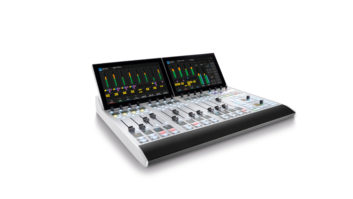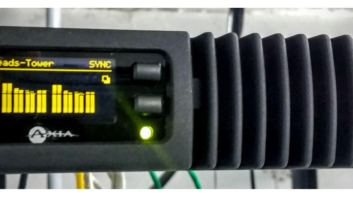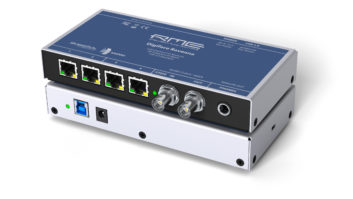The author is senior sales engineer of RCS.
It seems so long ago that audio over IP was “the dream.”
Think of it: The highest-quality digital audio flowing around the station just like the Internet, just waiting for us to tap into or to source. No more custom audio cabling running upwards of several dollars a foot to pull, attempting to manage pair counts in and out of studios and so on.

iStockphoto/Mihai Simonia That was the dream, but this time the dream came true. Now it’s reality and it really works.
With most of the major console manufacturers now offering their own “flavor” of AoIP, there is no doubt that there is a solution for almost any platform. Most even have integrated singling (virtual GPI/O) that travels right along with the affiliated audio so parallel control paths are either obsolete or at least the exception to the rule.
Since IP communication was designed to work with and for computers, it is an excellent choice for integrating with computer-based automation systems. Most automation systems easily can be interfaced using an AoIP platform. Worried about the stability of the AoIP platform? Don’t be. RCS has installed hundreds of automation workstations using AoIP over several years and the technology has proven itself over and over in even the most demanding broadcast environments.
Away you go
The success of AoIP begs the question: Are dedicated professional audio cards as we know them today a dead technology? No I don’t think so, but they are and will be changing to adapt to the IP platform.
I can’t tell you how many times I have had the question posed to me, “Why would I buy an audio card for a software-based driver/platform?” or “Why would I spend money on dedicated hardware when I can simply buy a software driver?”
The answer boils down to resources. It is true that you absolutely can simply load a single- or multi-channel AoIP software driver and route the audio in and out an available network card; however you are relying on the available horsepower of the computer and operating system to handle and manage your audio connection.
Depending on your needs and available horsepower (both hardware and software), simply using a software driver may be fine. However if you have come to love and need some of the advanced digital signal processing-based tricks that our industry’s audio card manufacturers have created, that DSP becomes a valuable resource.
At least some major broadcast audio card manufacturers (AudioScience and Digigram, to name two) have embraced the AoIP platform to offer solutions to broadcasters that combine some of the powerhouse features we have come to depend on while directly interfacing with these new platforms.
Features like pitchless time compression/expansion, on-card audio stream mixing and digital gain stage transformations are among the features DSPs bring to the party. Typically the DSP is paired up with a dedicated network card so that it looks and performs just like the audio adapters we have come to know and love, but instead of discrete audio in and out ports, it uses the AoIP platform for external interfacing. RCS offers you the choice to use software drivers or DSP hardware-based broadcast cards; in fact both methods are supported by many premier automation manufacturers.
What will become of dedicated routers that we use for routing signals to air and background records in an AoIP world?
As you might expect, RCS will still support and interface with them; but they aren’t your only option. Now that all of your audio can be pumped out onto an IP network, you just need to have a way to pick out the stream you want. Several AoIP platform manufacturers have software tools for doing that. Simply browse the available audio streams on your network, click to select and away you go.
How does the automation handle this process for route access? We simply have an interface that effectively “maps out” the sources and destinations that you designate necessary for the automation to have access to, and then the interface creates a virtual router for each station. All of the routing commands are translated and passed on to the AoIP platform for source and destination association, and then the AoIP network does the rest. Mixing sources that need to be on the air at the same time is often platform-specific, so confirm with your AoIP platform manufacturer the ability and methodology for doing so.
Once the implementation is complete, you will have a dynamic routing solution that typically integrates and forwards the associated GPI/O control functions right along with the audio routing.
Direct connection
Speaking of complex routing platforms, remember the challenges of wanting to place a workstation in an IT rack or utility room and extending the keyboard, video and mouse (KVM) signals back into the studio, while still having access to them in the rack room too?
Then add workstations set up with dual screens to make things more complicated. The amount of copper is nothing short of building an AM radial ground system for a multi-tower array and a rack full of cascaded components. Now there is an easier way, similar to AoIP.
KVM-over-IP solutions push the keyboard, video and mouse signals onto an IP network. All you need to access it is a small network appliance (node).
Cooler yet is the ability to push USB through the IP platform so that you can plug in thumb drives, touchscreens or other devices into the node and have it operate just like it is connected directly to the computer.
One platform called PC over IP, offered by Dell, even integrates an audio device into the platform. By simply dropping a card into the PC, you can even do a point-to-point direct extension without a formal network, just a piece of Cat-6 cable between the workstation and the node. This direct extension is ideal for smaller implementations where only a couple of workstations make up the entire system.
And the icing on the cake, the dual-monitor operation can be extended over a single Cat-6 cable. That’s right; dual monitors, keyboard, mouse USB all over a single cable. Now that’s efficient.
Let’s not forget about the routability of the signals, too. Once on the IP network, you can use a node anywhere on the network to pick up the signal. No dedicated point-to-point limitations. If you experience a failure, just point the node to a backup or alternate workstation and you are back in business without leaving the studio.
I could go on and on about legacy platforms that have moved over to IP — intercom, transmitter telemetry, phone systems — but for some readers this is old news; you’ve probably already jumped into the deep end of the pool, drank the Kool-Aid, been there/done that to one degree or another.
No matter your level of adaptation, it is hard to deny the benefits of hitching onto the IP bandwagon. It’s cheaper, cleaner, more powerful and dare I say even simpler in many cases than previous legacy platforms.
I can say without a doubt that we are looking forward to this migration to IP. Bring it on, bring it all on IP. We are ready!
Comment on this or any article. Write to[email protected].












